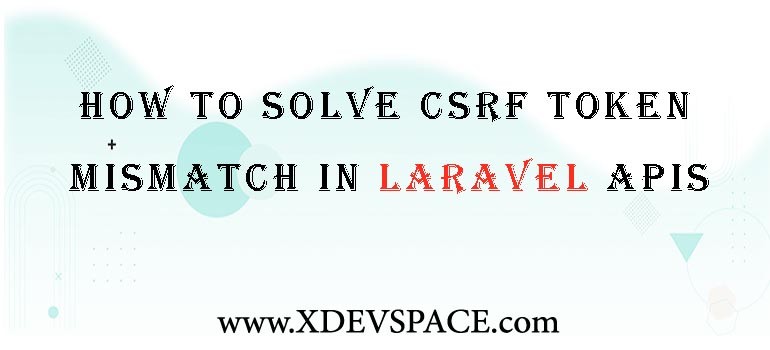
How To Solve CSRF Token Mismatch in Laravel APIs

CSRF (Cross-Site Request Forgery) token mismatches are a common issue when working with Laravel APIs.
– This guide will help you understand what causes these errors and how to properly handle CSRF protection in your Laravel applications.
What is CSRF?
Cross-Site Request Forgery (CSRF) is a type of security vulnerability where unauthorized commands are submitted from a user that the web application trusts.
– Laravel includes built-in CSRF protection to prevent these attacks.
Common Causes of CSRF Token Mismatch
– Missing CSRF Token in Request Headers:
- Frontend not including the X-CSRF-TOKEN header
- Incorrect token value being sent
- Token expired or invalidated
– Incorrect Configuration:
- CSRF middleware enabled for routes that should be excluded
- Missing VerifyCsrfToken middleware
- Incorrect token storage or retrieval
Solutions and Best Practices
1 - Frontend Implementation
// Using Axios
axios.defaults.headers.common['X-CSRF-TOKEN'] = document.querySelector('meta[name="csrf-token"]').content;
// Using jQuery
$.ajaxSetup({
headers: {
'X-CSRF-TOKEN': $('meta[name="csrf-token"]').attr('content')
}
});2 - Backend Configuration
// app/Http/Middleware/VerifyCsrfToken.php
protected $except = [
'api/*', // Exclude all API routes
'webhook/*' // Exclude webhook endpoints
];3 - Proper Meta Tag Implementation
<meta name="csrf-token" content="{{ csrf_token() }}">Security Considerations
– API Authentication
- Consider using token-based authentication (JWT, Sanctum) for pure API endpoints
- CSRF protection is primarily needed for web routes where cookies are used for authentication
– Route Protection
- Carefully evaluate which routes need CSRF protection
- Document any excluded routes and the reasoning behind exclusions
– Token Handling
- Never expose CSRF tokens in URL parameters
- Implement proper token rotation and expiration
- Handle token refreshing appropriately
Debugging Tips
– Check Network Requests:
- Verify the X-CSRF-TOKEN header is present
- Ensure token value matches the server-side token
– Server-Side Logging:
// Add to relevant controller or middleware
Log::debug('CSRF Token from request', [
'token' => $request->header('X-CSRF-TOKEN')
]);Common Error Patterns
- Token mismatch immediately after deployment
- Inconsistent errors across different environments
- Issues specific to certain browsers or clients
Best Practices Implementation
// routes/api.php
Route::middleware(['api'])->group(function () {
// Routes that don't need CSRF
});
// routes/web.php
Route::middleware(['web'])->group(function () {
// Routes that need CSRF
});
// app/Providers/AppServiceProvider.php
public function boot()
{
// Force HTTPS in production
if (config('app.env') === 'production') {
URL::forceScheme('https');
}
}
Remember to:
- Properly configure CSRF middleware
- Implement correct token handling on the frontend
- Regularly audit excluded routes
- Monitor for security issues
- Keep Laravel and its dependencies updated
- Tags :
- Laravel,
All Comments